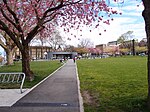Port of Vancouver (1964–2008)
The Port of Vancouver was a port located in and round Vancouver. It was the largest port in Canada, the largest in the Pacific Northwest, and the largest port on the West Coast of North America by metric tons of total cargo, with 76.5 million metric tons. The port amalgamated with the Fraser River Port Authority and the North Fraser Port Authority in 2008 to form Port Metro Vancouver, which has now adopted the Port of Vancouver name. In terms of container traffic measured in twenty-foot equivalent units (TEU), the port ranked in 2006 as the largest port in Canada, the largest in the Pacific Northwest, the fourth-largest port on the West Coast of North America, and fifth-largest in North America overall.The Port of Vancouver trades $43 billion in goods with more than 90 trading economies annually. The Vancouver Port Authority was the corporation responsible for management of the port, which, in addition to the city of Vancouver, includes all of Burrard Inlet and Roberts Bank Superport in Delta, a total of 233 kilometres (145 mi) to coastline.The Port of Vancouver is also the world hub for Canadian shipping company, Asia Pacific Marine Container Lines.
Excerpt from the Wikipedia article Port of Vancouver (1964–2008) (License: CC BY-SA 3.0, Authors).Port of Vancouver (1964–2008)
Rogers Street, Vancouver Strathcona
Geographical coordinates (GPS) Address Nearby Places Show on map
Geographical coordinates (GPS)
| Latitude | Longitude |
|---|---|
| N 49.2854 ° | E -123.0805 ° |
Address
Rogers Street
Rogers Street
V6A Vancouver, Strathcona
British Columbia, Canada
Open on Google Maps







